
Listen to this blog
Microsoft has added many new features to Dynamics 365 for Finance and Operations that will enable you to transform your business faster.
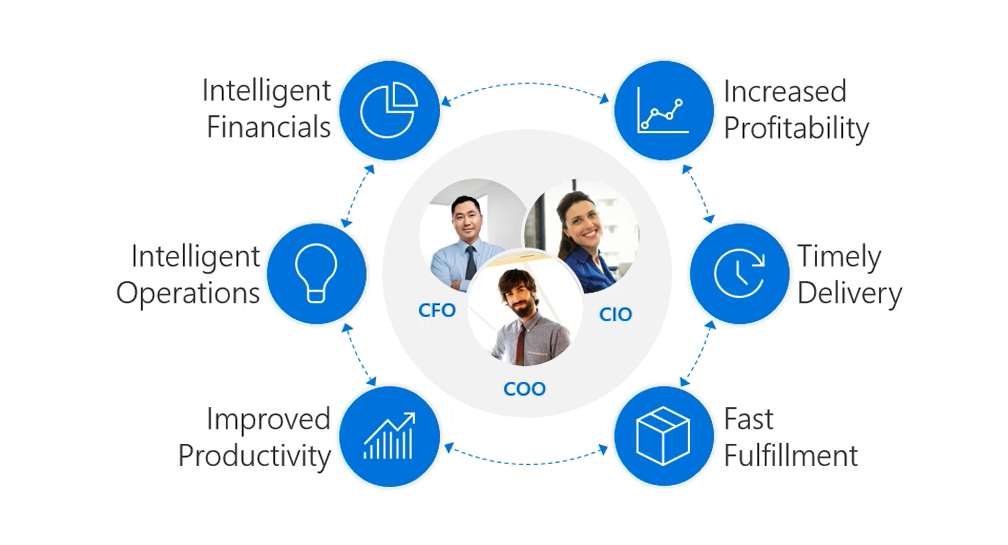
![]()
Real-time intelligence and insights into business data will help you proactively manage and grow your business globally. The common data service (CDS) integrates customer engagement applications across the Dynamics 365 portfolio of products, the built-in back-end Finance and Operations module, and core functionality like finance, retail, manufacturing enhancement, and extensible global support.

![]()
- Productivity and Usability
Usability enhancements will enable business users to view, filter, and save optimized views of data, improving productivity on daily tasks. Other enhancements will improve end-user performance for on-hand inventory reporting, master planning, consolidation of planned orders, and warehouse operations. Customers will also be able perform unassisted upgrades using upgrade automation.

![]()
- Personalization
Personalization improvements will enable users to remove columns from grids, add fields, and track additional information in the system by creating custom fields to tailor the application to fit their business. Business users will be able to create, save, and share multiple optimized views that can be targeted for certain user groups or business tasks. Saved views will greatly simplify the user experience and improve user productivity.
With WYSIWYG capabilities, you will have a better user experience and will no longer have to repeatedly exit and then re-enter personalization mode to make all the desired form modifications.
- Intelligence and Insights
Microsoft continues to improve extended analytical workspaces, and soon you will be able to personalize dashboards by combining data from Finance and Operations and other systems with rich visualizations.
With “bring your own database” (BYOD) functionality, users can create, save, and share multiple optimized views that can be targeted for user groups or business tasks. It also enables customization of analytical workspaces.
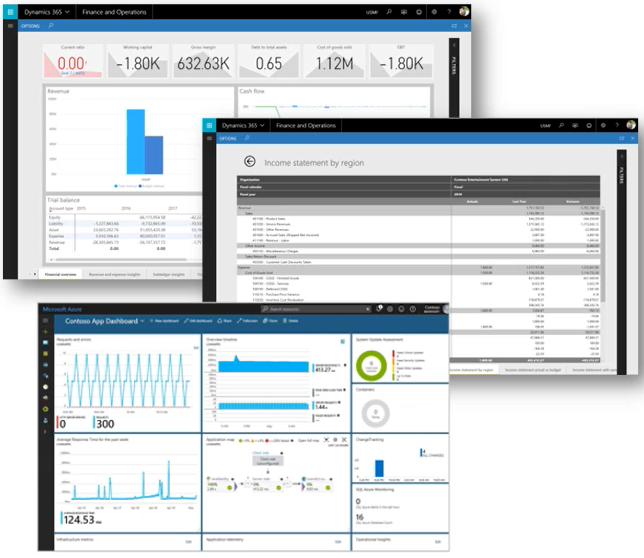
Companies prefer seeing their data in real time to enable faster decision making instead of relying on overnight scheduled refreshes. Real-time Power BI visibility lets you pin Power BI dashboards with real-time data to Microsoft Dynamics 365 for Finance and Operations. Some data, like from a Salesforce or Market content pack, is automatically refreshed for you. If you use a live connection or DirectQuery, the data will be updated automatically.
- Connected Ecosystem
Microsoft has created an ecosystem of products that are seamlessly integrated with Dynamics 365 for Finance and Operations. With the Data Management workspace, you will be able to configure multiple data sources. With CDS, you will have more than 200 out-of-the-box data sources that use advanced EDI capabilities to integrate with practically anything.
The Talent Management app leverages the capabilities of Office 365, Skype, and LinkedIn to attract talent. Azure Machine Learning identifies qualified candidates by comparing their profiles to your job requirements. Skype Interviews makes interviews more collaborative by adding a shared whiteboard and coding environment for real-time technical exercises. Features like onboarding support, benefits, workforce, and organizational management capabilities make Talent a complete “hire-to-fire” module.
Deeper integration provides a more seamless transition between the Talent app and Dynamics 365 for Finance and Operations.
The Field Services module has become more proactive. It engages customers, optimizes resources, and uses a more interactive and adaptable platform. It uses the IoT to proactively detect and create alerts and orders, with the deep Finance and Operations integration and work order data to be pushed to sales. It offers warehouse and purchase orders, invoice integration, and also enables account, product, and pricelist master data integration.
Project Service includes adjustments to approved time, expense, and journal lines, support for multiple time units on a single price list, and configuring a unit of time for estimating work on project tasks.
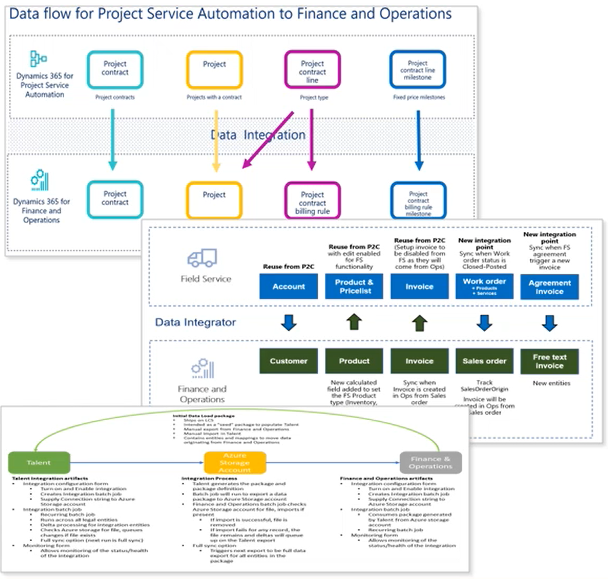
- Global Capabilities
Microsoft’s core capabilities keep improving and its enhanced features enable businesses to meet their requirements effectively.
Enterprise credit management capabilities automate credit management processes for accounting and finance professionals to proactively suggest credit control activities that improve cash flow, reduce bad debts, and provide new account control management.
With dual currency, the reporting currency becomes a secondary currency and tracks the reporting currency in fixed assets, Accounts Receivable, Accounts Payable, and bank management.
Finance and accounting professionals use revenue recognition capabilities to automate compliance with IFRS and ASC 606 financial reporting standards.
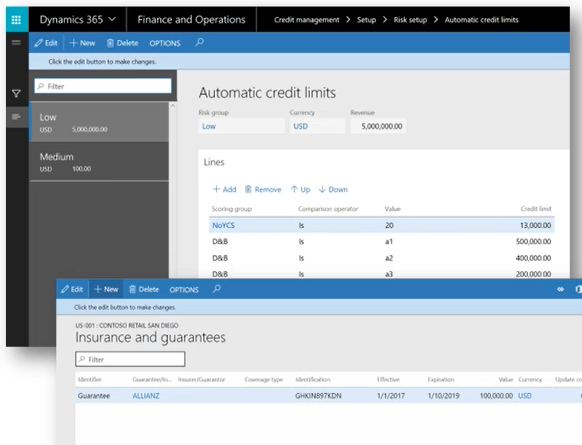
![]()
- Regulatory and Electronic Reporting
Every country has their own taxes and regulations. ERP systems must meet these local requirements, so Microsoft keeps adding localization features into Dynamics 365 for Finance and Operations.
Regulatory Services will provide functionality that can be integrated with any business application. This service allows developers building applications to focus on their core functionality rather than worrying about meeting the increasing number of legal requirements around the globe. Enhanced configurability features let partners and customers create extensions and customizations without coding. For example, they can configure the tax currency in tax documents to help customers with multiple branches in different countries.
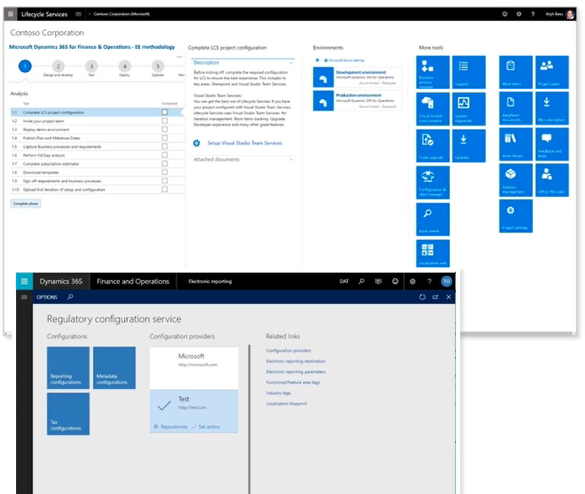
![]()
In accordance with the legal requirements of various countries and regions, Dynamics 365 for Finance and Operations supports formats for both incoming and outgoing electronic documents. Because you configure formats instead of code, creating electronic documents is faster and easier. Forms like Vendor Check, Customer Sales Invoice, and Customer Purchase Order can be configured without involving a developer.
The update also adds new features like automatic comparison of electronic reporting format executions with baselines for automatic test capabilities. Relative paths in electronic reporting formulas allow quick remapping of the format if you need to switch to another data entity or XML node with a similar structure.
- Optimization Advisor
Incorrectly configuring a module can adversely affect system performance and business operations. The correctness, completeness, and cleanliness of your business data also affects system performance, your organization’s decision-making capabilities, and employee productivity.
The Optimization Advisor workspace is a tool that lets power users, business analysts, functional consultants, and IT support functions identify issues in module configuration and business data. Optimization Advisor suggests best practices for module configuration and identifies business data that is obsolete or incorrect.
Optimization Advisor periodically runs a set of best practice rules. When a violation is detected, an optimization opportunity is generated and appears in the Optimization Advisor workspace. A user can take corrective action directly from the Optimization Advisor workspace.
- Distributed Order Management
Distributed Order Management (DOM) lets retailers take advantage of intelligent algorithms to optimize order fulfillment operations across their enterprise. DOM automatically determines the best possible fulfillment location across warehouses, distribution centers, or even stores based on user-definable profiles containing rules, scope, and delivery methods. Enhanced order fulfillment capabilities within Retail Modern POS and Cloud POS help turn each retail location into a micro-warehouse, ensuring that orders are filled as efficiently and cost-effectively as possible.
- Vendor Collaboration
The Vendor Collaboration module is targeted at vendors who don’t have electronic data interchange (EDI) integration with Microsoft Dynamics 365 for Finance and Operations. It lets vendors work with purchase orders (POs), invoices, consignment inventory information, and requests for quotation (RFQs), and also lets them access parts of their vendor master data. Notable features of this module include:
- Working with RFQs
- Vendor management, security, and compliance settings
- Working with POs (sending, confirming, changing, cancelling)
- PO status and version information
- Consignment inventory
- Catch Weight Product Processing
This functionality will provide support for using catch weight products as part of warehouse management processes. Catch weight products are often used in industries like the food industry where products can vary slightly by weight, size, or both. Catch weight products use two units of measure — an inventory unit (kilograms) and a catch weight unit (boxes).
Within warehouse management processes, catch weight products can be handled in different units like pallets and boxes. For example, business processes can be granularly defined to perform inbound weighing on a per-pallet level and capture the outbound sales process during picking or packing according to catch weight quantity (boxes).
Conclusion
The features mentioned in this post aren’t all that Microsoft offers. Microsoft’s roadmap for new releases includes many other features designed to meet the growing demands of business users, and they will continue to expand their products’ integration capabilities to support these users’ diverse needs and specialized niches.
This article is a part of our Dynamics 365 blog series that keeps companies updated about the latest developments in the world of tech. For further information on Dynamics 365 for Finance and Operations, please contact Visionet Systems today.




